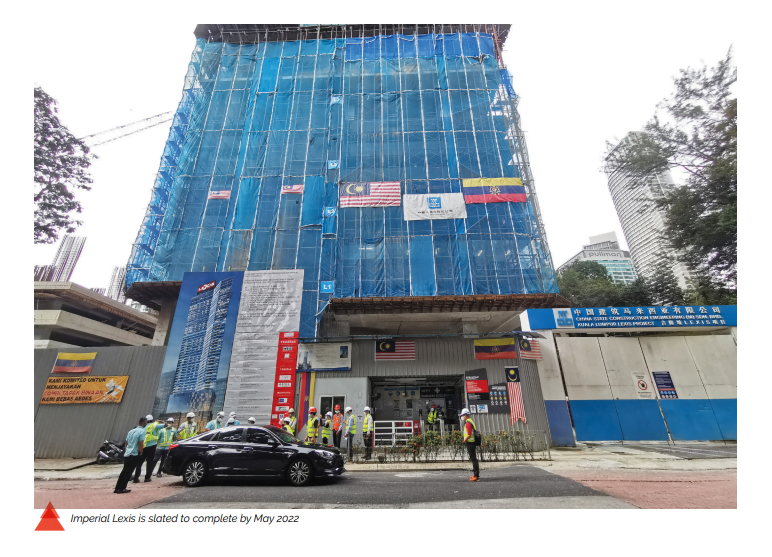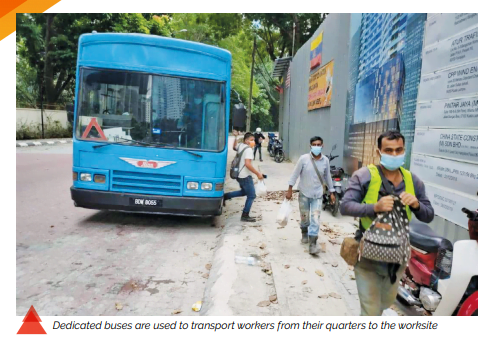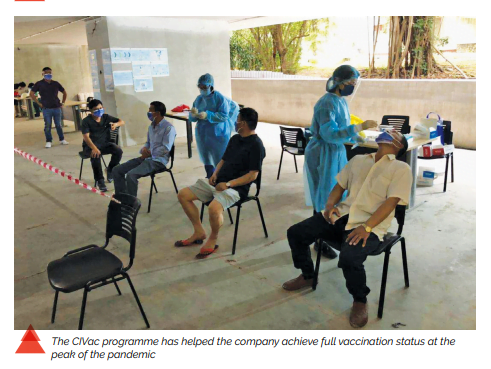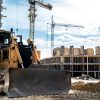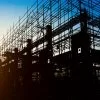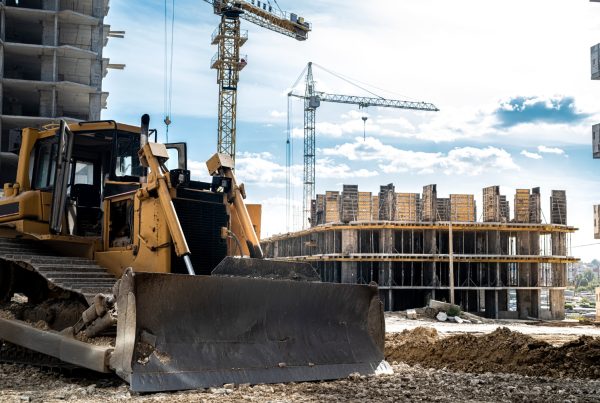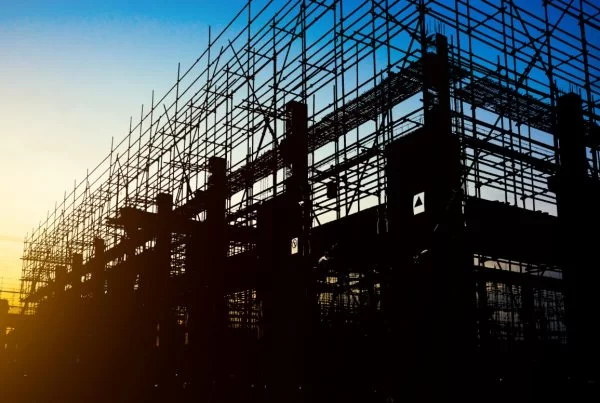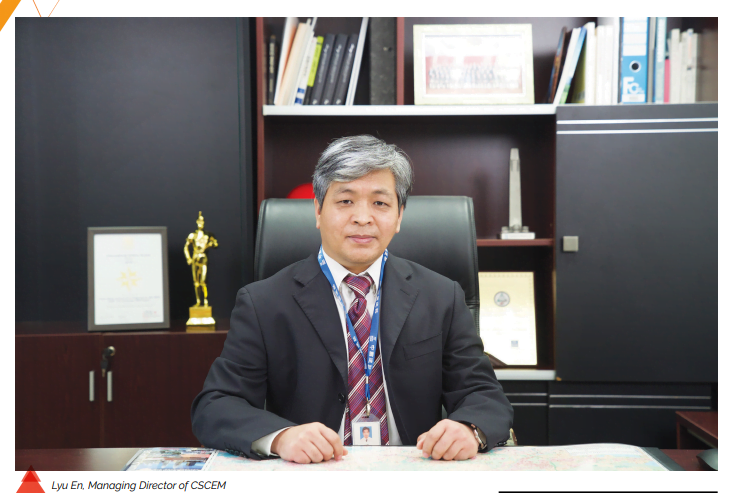
The soon-to-be-opened Imperial Lexis Kuala Lumpur is located within the famous KLCC enclave. This towering 54-story skyscraper, scheduled for completion in May 2022, is modern in style while radiating luxury in every manner. Each of the 440 guestrooms has its own private pool and sauna room, which is a first in Malaysia’s capital. In fact, the project is slated to achieve a world record with the most number of swimming pools in a highrise building.
Behind this ambitious project is the main contractor, China State Construction Engineering (M) Sdn. Bhd. (CSCEM). CSCEM is a wholly-owned subsidiary of China State Construction Engineering Corporation (CSCEC) in Malaysia. Founded in 1957 as a state company, CSCEC is globally renowned and has evolved to be China’s largest construction and real estate conglomerate and contractor of building works. It operates in over 130 countries worldwide with 29 branches and is ranked No. 13 in the Fortune Global 500 in 2021.
Smart System for Safety & Efficiency
CSCEM has been working hard behind the scenes to bring Imperial Lexis Kuala Lumpur to completion amidst the multiple lockdowns caused by the pandemic. The company has implemented a smart system for on-site management so that its workers can work efficiently during the pandemic.
“The system was initiated to solve the common problems we faced during the construction operations, such as safety measures, sustainable construction, insufficiency of supervision and personnel management.”
The main components of the comprehensive smart system include a facial recognition system, a tower crane surveillance system, an elevator automation control for emergency and real-time data reporting, and a system to monitor the limits of the cantilever unloading platform to prevent overloading. Additionally, the smart system also includes the server room, entrance setup, CCTV, wiring connection, and relevant systems software.
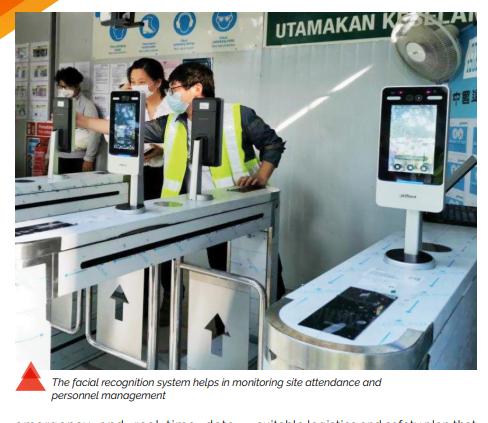
According to Lyu En, Managing Director of CSCEM, the decision to implement the smart system was made before the onset of the pandemic. Still, it works well during the pandemic because it reduces the need for close physical contact between workers. At the same time, it improves management efficiency.
“The system was initiated to solve the common problems we faced during the construction operations, such as safety measures, sustainable construction, insufficiency of supervision and personnel management. To overcome these issues, we need a system that can collect sufficient on-site information for further analysis and generate a suitable logistics and safety plan that is best suited for the specific site,” said Lyu En.
By adopting the smart system, CSCEM has discovered innovative ways to decrease health and safety risks in their construction project and meet the ever-evolving anti-pandemic SOPs.
For instance, the facial recognition system helps to keep a close eye on the worksite for added safety and security. The system comes with built-in facial recognition and a body temperature screening system to ensure workers are fit for work. At the same time, its site attendance module records the workers’ attendance. It enforces SOP compliance through effective site attendance and personnel management by ensuring the optimum and SOP-compliant number of workers, who are not Covid-19 positive, are on-site at any one time. “This not only ensures the health and safety of the site workers but also maintains an operational construction site by limiting the risk of closure due to positive Covid-19 cases,” Lyu En stated.
To Lyu En, the tower crane surveillance system has the biggest impact on worksite health and safety. “It helps to monitor the limitations of the tower crane, such as over-lifting, swing coverage, informative storage, increases the visuality of the operator and consequently, eliminates a lot of risks.”
CSCEM also designed a feasible formwork and safety concept tailored to the tight construction timetable and the client’s stringent safety standards. These can be seen in the aluminium formwork for swimming pools and floor slabs, the shear wall panel system for the RC Wall, the self-climbing system lift core wall formwork, and the building boundary protection screens.
“It helps to monitor the limitations of the tower crane, such as over-lifting, swing coverage, and informative storage increases the visuality of the operator and consequently, eliminates a lot of risks.”
Pandemic Safety Measures
Among the measures implemented on the construction site to minimise the risk of infection are temperature monitoring, regular sanitisation and disinfection of the worksite and workers’ quarters, MySejahtera check-ins at the main entrance and the site office, and physical distancing on-site and at the office.
“We also provide buses to transport workers from their quarters to the worksite and swab test our workers and office staff regularly in accordance with the SOP,” said Lyu En. Virtual meetings are also encouraged as much as possible. He is pleased to report that they have so far passed all site inspections by CIDB, DBKL, KKM, JKKP, MITI, and the police with flying colours.
By the end of August 2021, all 351 of their staff were fully vaccinated, thanks to the Construction Industry Vaccination (CIVac) programme.
“Overall, the CIVac programme is greatly beneficial to all our workers since it helped us achieve a full vaccination status at the peak of the outbreak resulting in a safer working environment,” said Lyu En. He commended the entire programme to be very well designed and set up, and the supporting staff who were on-ground were very polite and well organised. While he is grateful to CIDB for making this happen, he mentioned a minor inconvenience during the online registration. “Occasionally, it took a very long time to complete an application due to the unstable internet connection,” he explained.
“The CIVac programme is greatly beneficial to all our workers since it helped us achieve a full vaccination status at the peak of the outbreak resulting in a safer working environment”
Costs of the Pandemic
The numerous lockdowns have caused delays for the construction industry, and CSCEM is no exception. “The Imperial Lexis Kuala Lumpur project has been delayed as a result of the numerous lockdowns. According to our calculations, the entire cost of the new SOP measures and total lockdown is about RM3,148,500.00 as of the end of August 2021. The sector is experiencing a shortage of skilled personnel, which has hampered progress. Additionally, some suppliers have increased material prices drastically without warning, resulting in higher construction costs,” Lyu En lamented.
“For pandemic mitigation measures, we spent approximately RM969,000.00 for anti-pandemic related supplies, such as masks, alcoholic sanitisers, hand sanitisers, medicines, swab tests, separate isolation rooms, daily disinfection of worksites and workers’ quarters, bus transportation fees, among others,” he shared. The highest cost, he divulged, was the cost of workers staying at home during the lockdowns. “The construction industry is a very hands-on one where the majority of our work has to be done on-site and not from home. Every day that we are not at work on-site costs us tens of thousands of ringgit.”
That said, the safety and health of their workers remain the priority, Lyu En said assuringly. As such, he is adamant that the expenditure on safety measures should not be reduced in any way. “By providing a working environment that is safe and hazard-free, my workers will be able to function with high efficiency and productivity,” he said wisely.
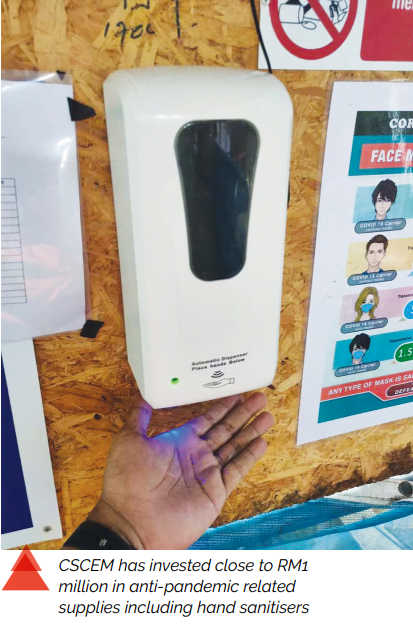
“Prevention is always better than cure. While some contractors may think they are saving money by skimping on safety costs, they are actually putting the business at risk for bigger losses in the long run. I would rather invest my money to eliminate the risk altogether!”
Lyu En opined that there is one additional and effective way the government could help ease the burden for main contractors. “The materials prices have risen rapidly during the pandemic period, which has had a significant impact on the main contractors. Unfortunately, according to the contract, principal contractors cannot claim any additional costs incurred due to market frustration. As such, we strongly suggest that the relevant authorities initiate some policies to help the main contractors ride through these tough times.”
No One is Safe Until Everyone is Safe
When it comes to safety, every single worker plays an important role. CSCEM ensures that the message is conveyed effectively from the top management to the workers on-site via a safety policy developed by the company’s senior management and the safety department. “Each project site will have a safety execution committee to execute the company’s safety plan. These include safety induction for all employees, toolbox meetings to raise safety awareness, and an awards system for workers who serve as positive role models for safety, among others,” explained Lyu En.
As Managing Director, Lyu En is responsible for establishing procedures to prevent the spread of Covid-19 and is constantly reviewing and updating the requirements that are mandated by the authorities. “With the support of my safety team, I oversee and manage the safety measures for pandemic prevention such as education and training, PPE supply, sanitisation procedures, Covid-19 SOP management, enforcing specific company requirements and liaising with the authorities,” he said. These are additional responsibilities he has acquired due to the pandemic, but he willingly takes them on for the sake of the company’s survival.
“The most difficult obstacle to overcome is the education and culture of the workforce. Because of the diversity of cultures and faiths, it takes time and resources to instil the importance of safety in the minds of employees,” Lyu En mused. However, getting everyone on board the safety bandwagon is not impossible, as attested by their success in garnering two International Safety Awards from the British Safety Council (BSC) in 2019 for their Maya@Likas Project and Johor Bahru Forest City Landmark Phase 1 Project.
“It begins with people caring, holding everyone accountable, and educating everyone – from managers to workers – about the importance of safety,” Lyu En emphasised. He added that the key contributing factor is good safety management, including establishing clear roles and responsibilities and top management commitment to driving safety management. “We are also instilling safety responsibilities at all levels and creating a safe working environment by providing resources, support, education, knowledge sharing, training, and recognition to everyone involved in our organisation. There are no shortcuts.”
For Lyu En, this is the sure-fire way to meet the company’s contractual obligations on time, every time, without compromising on their workers’ health and safety
“Because of the diversity of cultures and faiths, it takes time and resources to instil the importance of safety in the minds of employees.”
